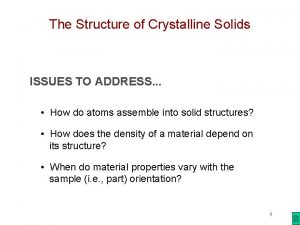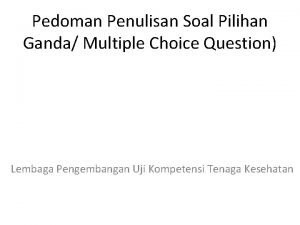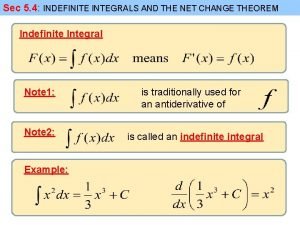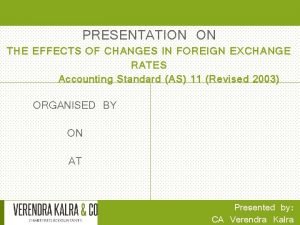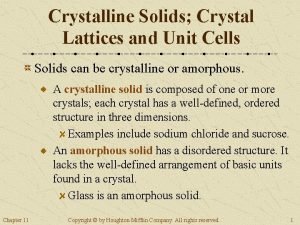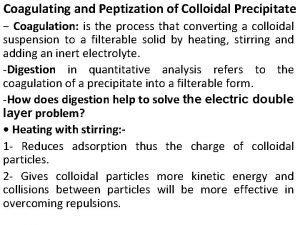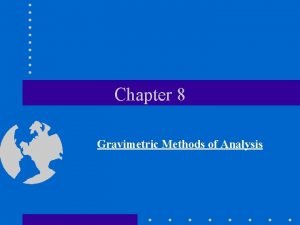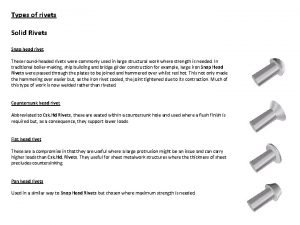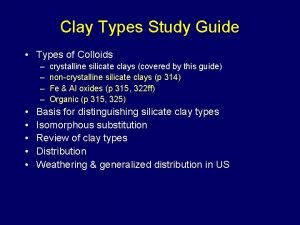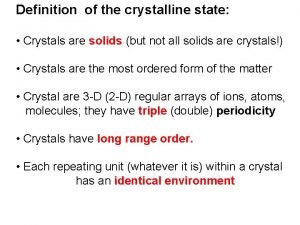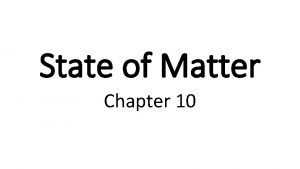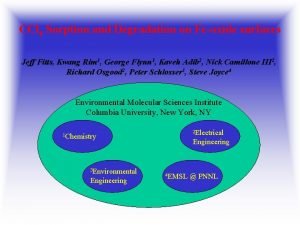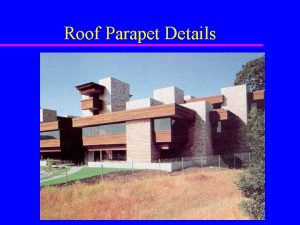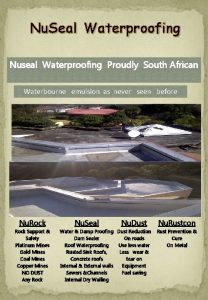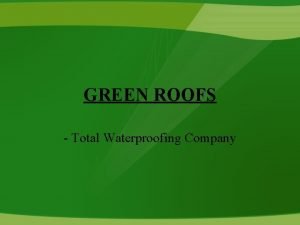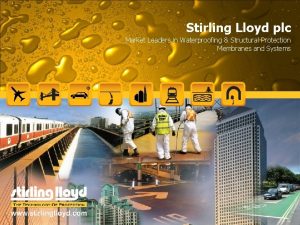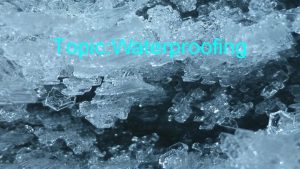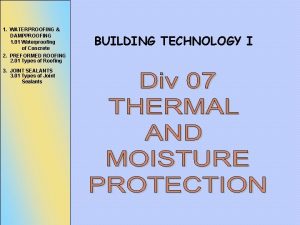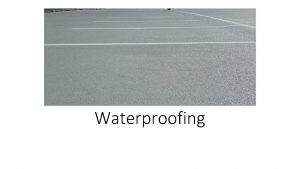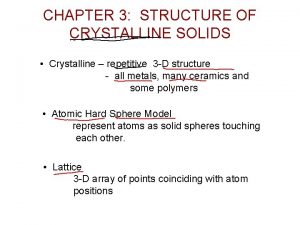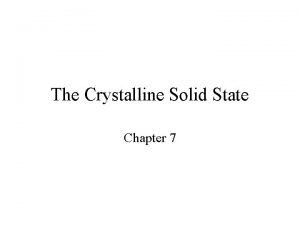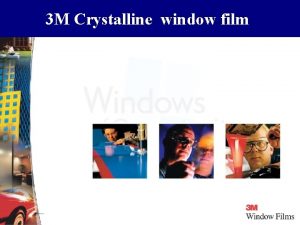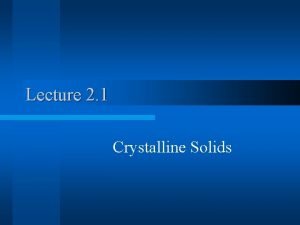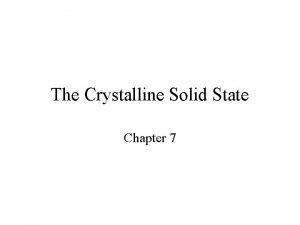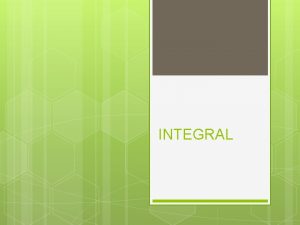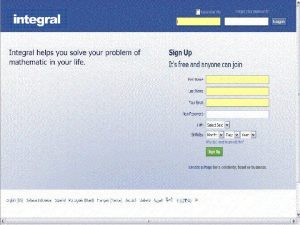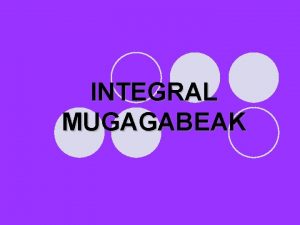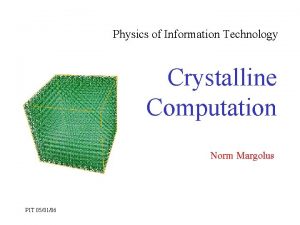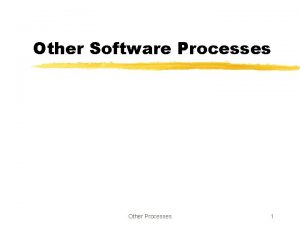The Other Waterproofing Option INTEGRAL CRYSTALLINE WATERPROOFING TECHNOLOGY























































- Slides: 55

The Other Waterproofing Option INTEGRAL CRYSTALLINE WATERPROOFING TECHNOLOGY

Concrete Basics History 1. Major construction product that has been used for years. 2. Can be molded or formed into virtually any shape

Concrete Basics Composition 1. Is a heterogeneous composition of coarse and fine aggregate particles held together with a cement paste. The paste is the “glue” made from cement and water that hardens due to a chemical reaction called hydration. 2. Cement paste normally constitutes 25 -40% of the concrete’s total volume. The paste is porous and is prone to water movement through pores and micro cracks present in the paste. 3. The quality of the concrete depends on the quality of the paste and aggregate, as well as the bond between the two. In properly made concrete, every aggregate particle should be covered with paste and the spaces between the aggregate particles completely filled with paste.

Concrete Basics Durability 1. Defined as its resistance to the degradation process such as weathering, chemical attack, abrasion, impact and physical strains. 2. The life expectancy is dependent on 1) the choice and proportion of ingredients, 2) quality of workmanship, 3) the conduct of proper curing process. If any one of these areas are missing, the durability of the concrete is compromised.

Concrete Basics Deterioration of Concrete 1. Due to lack of durability, rather than deficient strength. 2. Concrete structures can become unserviceable due to gradual weakening arising from concrete deterioration and steel corrosion.

Concrete Basics Degradation Mechanisms 1. Concrete deterioration can be due to adverse mechanical, physical, or chemical causes. In most cases, one or more of these mechanisms is at work long before the degradation is observed. 2. In terms of deterioration of the concrete due to physical or chemical causes, the mobility of fluids or gases through the concrete are nearly always involved. 3. Important degradation mechanisms in concrete structures include the following a) Corrosion of reinforcing steel, b) Alkali-Aggregate Reactions, c) Carbonation, d) Sulfate attack, and e) Freezing and thawing.

Concrete Basics Corrosion of Reinforcing Steel 1. Common Causes A. Localized breakdown of the passive film on the steel by chloride ions. B. General breakdown of the passive film by neutralization of the concrete, predominately by reaction with atmospheric carbon dioxide. 2. Passive layer A. Steel embedded in hydrating cement paste forms a passive oxide layer which adheres to the steel surface and gives complete protection from corrosion. The maintenance of the passive layer is conditional on the adequately high Ph of pore water.

Concrete Basics Carbonation 1. Occurs when Ph of pore solution drops as low as 8. 5. At this level, the passive film on the steel is no longer stable and corrosion begins. 2. The rate of Carbonation increases significantly if the concrete has a high permeability due to porous paste, porous aggregate, and high water to cement ratio, low cement content, short curing time, or poor consolidation. 3. Carbonation does not actually hurt the concrete, but the lowering of the Ph directly effects the passive layer protection that leads to the corrosion of the embedded steel. 4. Corrosion of the reinforcing steel will eventually lead to the failure of the concrete. Steel expands as it corrodes. The resulting stress will generally fracture the concrete cover. These cracks provide a path for water to carry oxygen and corrosive chemicals to the steel.

Concrete Basics 1. Alkali-Aggregate Reactions (AAR) A. Is the reaction between the active mineral constituents of some of the aggregate and the sodium and potassium alkali hydroxides in concrete. B. Alkali-Aggregate Reactivity forms, a) Alkali-Silica, b) Alkali-Carbonate, both result in the swelling of the concrete. C. Indicators of the presents of AAR are, a) network of cracks ( map cracking), b) closed or spalled joints, c) displacement of different portions of the structure.

Concrete Basics Sulfate Attack 1. Attacks concrete by reacting with hydrated compounds in the hardened cement paste. The expansive reactions can induce sufficient pressure to disrupt the cement paste resulting in the degradation of the concrete. 2. Sulfate attack is not common, but can occur where soil is high in sulfate.

Concrete Basics Freezing and Thawing damage 1. When water freezes to ice, it occupies 9% more volume than when it was a liquid. If water is filling the pores of the concrete, the results can be very damaging.

Concrete Basics Water penetration is the root cause of concrete failure. 1. Note that in every case, it is the presence of moisture or water within the concrete that is at the root of the destructive process.

Concrete Basics Durability and Permeability 1. Permeability determines the vulnerability of concrete to external forces and in order to be durable, concrete must be relatively impervious. 2. The durability of concrete is fundamentally based on the permeability of concrete.

Concrete Basics Permeation 1. Controls the ingress of moisture, ionic and gaseous species in concrete. 2. Since water or water born chemicals affect the durability of the concrete, the permeability of the concrete is the major factor in its longevity.

Concrete Basics Transport Mechanism 1. The ingress of deteriorating substances takes place through the pore system in the concrete matrix or micro cracks. There are several factors that determine the rate at which a substance flows through the concrete matrix, 1) Diffusion, 2 Capillary Action, 3) Permeation. 2. Diffusion is the process by which fluid can pass through concrete under the action of a concentration gradient. It is defined as “ the transfer of mass by random motion of free molecules or ions in the pure solution resulting in a net flow from regions of high concentration to regions of lower concentration of the diffusing substance”. 3. Capillary Action transports liquids through porous solid by way of surface tension acting in the capillary pores. 4. Permeability is defined as the ease with which a fluid can flow through a solid.

Concrete Basics Conclusion Low porosity/ Penetrability of concrete to moisture is the first line of defense against frost damage, acid attack, sulfate attack, corrosion of steel embedment and reinforcement, carbonation, alkali-aggregate reaction, efflorescence, and other concrete ailments.

Dampproofing vs Waterproofing Dampproofing 1. Applied as a surface coating or integral part of concrete. 2. Hydrophobic 3. Designed to prevent water from absorbing and wicking through wet concrete. 4. Will not resist water under pressure. Structures under hydrostatic pressure must be waterproofed.

Hydrophobic vs Hydrophilic Hydrophobic or water repellent products repel water by increasing hydrophobicity. They reduce absorption, but are not enough to resist significant water pressure. Hydrophilic chemicals absorb and utilize water to catalyze and react with cement particles to produce elongated crystalline structures. These structures physically block pores, cracks, and ITZ to sufficiently resist the penetration of water under pressure.

Positive and Negative-Side Waterproofing Positive side is where the concrete comes in contact with the water. Negative side is where the waterproofing is applied to the “dry side” of concrete. Negative side waterproofing provides easy access for remedial type projects.

Waterproofing Materials External Membranes 1. Fluid-Applied membranes 2. Sheet Applied membranes

Waterproofing Materials Fluid-Applied Membranes 1. Urethane, rubber, plastic, vinyl, polymeric asphalts, or combinations of the above. 2. Applied by spray or rolling 3. Easy to apply, conforms to surface texture, do not have to seam. 4. Care must be taken at termination edge to avoid disbonding. 5. Blistering or pin holes may develop if substrate is damp or wet, since membrane is not breathable. 6. Controlling thickness is difficult. 7. Most fluid systems are not durable and will not resist abrasion, weathering, or UV degradation.

Waterproofing Materials Sheet Membranes 1. Normally made from thermoplastics, vulcanized rubber, and rubberized asphalt. 2. Applied either fully adhered or loose, must be seamed. 3. Bentonite is made of clay, the clay swells when wet. Sheets are overlapped, not seamed. 4. Sheet goods are more durable than fluid applied, have a consistent thickness, and bridge openings in concrete. 5. Suffer from adhesion problems. 6. Little tolerance for rough or irregular surfaces. 7. Seams can fail. 8. Both fluid-applied and sheet membranes systems are prone to punctures. Water traveling under the membrane makes leak repair difficult.

Waterproofing Materials Internal Waterproofing 1. Known as integral waterproofing, are products that perform their function within the pores of the concrete as to on the surface. 2. Designed to migrate into the concrete from a surface applied carrier, or mixed into the concrete during its production. 3. Extremely durable. 4. Not subject to punctures, tearing, or abrasion. 5. Seamless. 6. Reactive and Un-reactive

Waterproofing Materials Un-reactive 1. Sodium Silicate, Bentonite, Water Repellents 2. Some may have a reactive effect during hardening of the new concrete, but do not reactivate in the presence of water. 3. Act as a densifier to concrete. 4. Attempt to make concrete waterproof by reducing permeability to the point water can’t flow through it. However, it does not have the ability to regenerate thus as the inevitable joints or cracks appear, water has clear access to the substrate. Reactive 1. Are able to create truly waterproof structures because they can address moisture penetration through joints and cracks, in addition to the mass concrete. They respond to moisture by forming new chemical compounds which grow to seal off moisture. Essentially, all truly reactive products are crystalline in nature and grow crystal formations to block cracks, pores and ITZ.

Waterproofing Materials Crystalline Waterproofing 1. Has been used for over 50 years in Europe and North America. Most countries in the world are using this system. 2. When applied to concrete, crystalline chemicals create a reaction that causes long narrow crystals to form and fill pores, capillaries and hairline cracks. As long as moisture is present, the crystals continue to grow. Once the concrete has cured and dried, the crystalline chemicals remain dormant, until another dose of water causes the chemical reaction to begin again, and grow crystals to shut off the water. 3. The ability of crystalline products to self heal is one of their most unique and dramatic benefits. 4. Seals cracks on average of 0. 4 -0. 5 mm. Real world experience often produce results of cracks up to a millimeter being sealed. 5. Incorporating crystalline technology into concrete ensures that minor cracking that occurs even years later can self heal without any outside intervention. This dramatically reduces long-term maintenance and repair costs. 6. Crystals can take days, even weeks to form, but become a permanent part of the concrete. 7. Will not crack, peel, tear, or wear away, even against high hydrostatic pressure. 8. Perfect for blind wall application. 9. Protects reinforcing steel by preventing water borne contaminants and chloride-laden liquids. 10. Saves time on construction schedules since it can be applied to green concrete. No need to wait for membrane application, back filling can start right away.

Foxfire Enterprises, Inc Products Integral Waterproofing 1. P-1007 2. PL-1007 3. L-1007 4. Catalyst

Foxfire Enterprises, Inc Products Water Repellents 1. 5000 WB 2. Stain Repellent

Foxfire Enterprises, Inc Products Cleaners 1. Heavy Duty Concrete Cleaner 2. Masonry Cleaner Dark/ Light 3. Restoration Detergent 4. MMR Mold Mildew Remover 5. Efflorescence Remover

Foxfire Enterprises, Inc Products Degreasers 1. Super Blue 2. Super D

Foxfire Enterprises, Inc Products Adhesive Remover

Foxfire Enterprises, Inc Products Graffiti 1. Graffiti Stripper 2. Anti-Graffiti Coating

Foxfire Enterprises, Inc Products Pump Flush 1. #89 2. #167

Foxfire Enterprises, Inc Products Wood Restorer

Foxfire Integral Waterproofing Foxfire P-1007 1. A chemical hardener and densifier (crystalline technology) 2. Reacts with the free calcium hydroxide in the cement paste forming a silica hydro gel which fills the capillaries. 3. Chemical reaction can take up to 30 days depending on chloride and acidic residual concentration within the capillary network. Normal cure time is 1 -7 days. 4. Water base Potassium. 5. Soluble Chloride reducer. 6. Can be used as a cure & seal 7. For use on dense concrete ( penetrates 2”-4” into concrete substrate).

Foxfire Integral Waterproofing P-1007 Benefits 1. Non-Flammable 2. Non-Toxic 3. No Voc’s 4. Reduces vapor emissions 5. Non-membrane forming (breathable) 6. Does not effect bondability 7. Self-healing 8. Will withstand wind driven rain 90 mph+ 9. Reduces and prevents efflorescence 10. Decreases floor maintenance and wear 11. UV stable 12. Will not absorb water or contribute to wall or floor sweating 13. Excellent color enhancer for stained or colored concrete 14. Improves concrete resistance to chemicals, weathering, dusting, fungi, mildew, mold, freeze-thaw, stains from organic acids, alkalis, salts, foods, fats, oil and grease.

Foxfire Integral Waterproofing Application Cured Concrete 1. Surface must be clean and free of oils, grease, curing agents, coatings, sealers, or other membranes that could inhibit penetration of the P-1007 2. Do not dilute 3. Shake well 4. Apply to the point of refusal, normally 2 coats 20 -40 minutes apart 5. P-1007 requires a Ph level of 10 or greater, if unsure of Ph level, after final application of P-1007, wait 30 -40 minutes and apply an application of Catalyst at a rate of 200 sqft per gallon. 6. Once Catalyst is applied, or if Catalyst is not used, wait 30 -40 minutes, and apply a mist of potable water over the concrete surface to break up any crystals that might have formed on the surface. . This will clean the surface for any topical products being applied over the P-1007 (i. e. 5000 WB, or a membrane forming coating) 7. Concrete can be put back in service once potable water has been applied

Foxfire Integral Waterproofing Application New Concrete 1. Apply upon removal of forms, or disappearance of bleed water and when concrete won’t be marred by walking on it. 2. Apply with low pressure sprayer, roller or brush. 3. On vertical surfaces, apply from top down. Flooding surface so that bleed is 6 -8 inches below spray pattern. Apply second coat within 30 -40 minutes. 4. On horizontal surfaces, flood surface to keep wet for 3 -5 minutes. Apply second coat within 30 -40 minutes. Avoid puddles of material, broom excess material to porous areas. 5. Dry to touch in 2 -6 hours depending on temperature and humidity. 6. Coverage rate 300 -400 sq ft per gallon.

Foxfire Integral Waterproofing Foxfire PL-1007 Ø Water base Potassium/Lithium Ø Ø Ø For use on more porous concrete surfaces ( gray block, architectural block, pavers, etc. ) Same benefits as P-1007 Same application process as P-1007

Foxfire Integral Waterproofing Foxfire L-1007 1. Water base Lithium 2. Same benefits as P-1007 and PL-1007 3. Same application method as P-1007 and PL-1007 4. Will not contribute to Alkali-Silica. Reaction (ASR) 5. Does not contain Sodium or Potassium Silicates. When properly applied will not leave a white bloom.

Foxfire Integral Waterproofing Foxfire Catalyst 1. Water Base 2. Restores Alkali for fast consistent sealer reaction 3. Voc compliant 4. Use where Ph level is lower than 10 or if unsure of Ph content

Foxfire Water Repellents Foxfire 5000 WB 1. Water base, modified Silane/Siloxane 2. For use on concrete, masonry, and wood 3. Penetrates up to ¼” 4. Will not affect surface profile 5. Low odor 6. Voc content less than 37 g/L 7. Use on horizontal or vertical above grade surfaces 8. Can be applied with low pressure sprayer or minimum ½” nap roller 9. Most surfaces require only one coat 10. Mildew and Fungus resistant 11. Non-flammable 12. UV resistant 13. Breathable vapor emission blocker 14. High resistance to wind driven rain when applied over P-1007 or PL-1007 15. Available as a Cure & Seal to reduce hair-checking, thermal cracking, and excessive shrinkage cracking in new concrete

Foxfire Water Repellents Foxfire Stain Repellent 1. Repels stains, oil, food products & graffiti 2. Breathable 3. No change in surface appearance 4. High resistance to Alkali attack 5. High resistance to wind driven rain when applied over P-1007 or PL-1007 6. Can be used indoors or out 7. Application similar to 5000 WB 8. Compatible with 5000 WB

Foxfire Cleaners Foxfire Heavy Duty Concrete Cleaner 1. Removes oil, grease, and dirt residue. 2. No CFC’s, biodegradable 3. USDA authorized for use in federally inspected meat and poultry plants 4. Non-toxic, Voc level less than 24 grams/kg 5. Non-flammable 6. Water base 7. Penetrating, will purge contaminants from substrate

Foxfire Cleaners Foxfire Masonry Cleaner Light/Dark 1. Cleans airborne dirt, exhaust residue, and industrial pollutants 2. No CFC’s 3. Non-toxic, Voc compliant 4. Bio-degradable, low odor 5. Use on concrete, pre-cast or cast in place, aggregate, brick and mortar 6. Use dark cleaner on dark colored brick, and light cleaner on lighter colored brick. Light Masonry Cleaner has a slight acidic solution that may stain darker brick. 7. May be diluted

Foxfire Cleaners Foxfire Restoration Detergent 1. Water based, Non-Hydrofluoric acid detergent 2. Removes biological stains, metal-mineral oxide stains, dirt, excess mortar and smears. 3. Voc compliant, less than 1% volatile organic compounds 4. Low odor 5. Use on concrete, brick, limestone, precast, sandstone, terrazzo, anodized aluminum, EIFS, uncoated stainless steel, and roofs. 6. Do not use on polished marble, glazed surfaces, copper, brass, or bronze

Foxfire Cleaners Foxfire MMR Mold, Mildew Remover 1. Removes mold, mildew, fungi, moss, and algae 2. No CFC’s 3. Non-toxic, Voc compliant 4. Non-flammable 5. Bio-degradable 6. Low odor 7. Use on concrete, masonry, wood, stucco, metal, tile, and grout 8. Can be used indoors and out

Foxfire Cleaners Foxfire Efflorescence Remover 1. Eliminates water soluble salts from masonry surfaces 2. Removes rust stains caused by iron in water 3. Bio-degradable 4. Can be diluted 5. Replaces heavy acids, Voc 10 g/1000 g 6. Non-flammable

Efflorescence Before Treated with P-1007 and 5000 WB

Foxfire Degreasers Foxfire Super Blue 1. Removes heavy concentrations of grease, oil, tar, road grime, and soot 2. No CFC’s 3. Non-toxic, Voc level 0. 9 pounds/gallon, or 108 g/kg 4. Non-flammable 5. Low odor 6. Bio-degradable 7. Non-hazardous (Ph 10. 5) 8. Can be used on concrete, painted steel, copper, aluminum, galvanized steel, bronze, and plastic surfaces 9. Removes paint oxidation and smoke from ceilings and walls

Foxfire Degreasers Foxfire Super D 1. Used in dip tanks for cleaning engine blocks and other engine parts 2. Removes cutting oil and lubricants from parts after the manufacturing process

Foxfire Graffiti Products Foxfire Graffiti Stripper 1. Non-flammable 2. Thixotropic gel with slight odor 3. Use on glass, masonry, metal, plaster, fiberglass or wood 4. Normally will soften or wrinkle coating within 20 -30 minutes 5. May not remove some cross-linked epoxies and urethanes

Foxfire Graffiti Products Foxfire Anti-Graffiti Coating 1. One part system that is effective on many surfaces for easy removal and protection from graffiti 2. Water base 3. Surface will have a waxy appearance 4. Weather resistant 5. Good water repellency 6. Water vapor permeable

Foxfire Adhesive Remover 1. Softens adhesives and surface materials for easy removal 2. Use indoors or out 3. No odor, fumes, or caustics 4. Voc compliant 5. Water soluble

Foxfire Accessory Products Foxfire Pump Flush #89 and #167 1. Are non-hazardous colorless liquids with low toxicity. Both provide good solvency for a wide variety of resins, including acrylics, epoxies, alkalydes, polyesters, nitrocellulose, polyurethanes, and polyureas 2. Primarily used to clean pumps, mixers, and hose systems 3. Use to strip wax and floor cleaners 4. Moderate evaporation rate

Foxfire Wood Products Foxfire Wood Restorer 1. Designed to clean and restore exterior wood surfaces, decks, and wood shake roofs 2. Water base, biodegradable, Voc content 100 g/L 3. Removes mill glaze, dirt, and general weathering 4. Eliminates mold, mildew, and fungus 5. Brings wood back to that new lumber look 6. Will not bring back natural wood color to pressure treated green lumber 7. 5000 WB can be applied over restored wood surface to seal out moisture
 Crystalline solid
Crystalline solid Volume to atoms
Volume to atoms Konvergensi option adalah
Konvergensi option adalah Stock options terminology
Stock options terminology Integral sec^5
Integral sec^5 Integral citation
Integral citation Integral and non integral citation
Integral and non integral citation Surface integral of scalar function
Surface integral of scalar function Exchange difference of integral foreign operation is
Exchange difference of integral foreign operation is Integral udv = uv - integral vdu
Integral udv = uv - integral vdu Amorphous vs crystalline
Amorphous vs crystalline Anisotropy
Anisotropy Crystalline solids
Crystalline solids Crystalline substances
Crystalline substances What is crystalline candy
What is crystalline candy Polycrystalline solids
Polycrystalline solids Coprecipitation errors
Coprecipitation errors Difference between occlusion and mixed-crystal formation
Difference between occlusion and mixed-crystal formation Difference between colloidal and crystalline precipitate
Difference between colloidal and crystalline precipitate Volatilization gravimetry
Volatilization gravimetry Types of rivets
Types of rivets Crystalline solid and amorphous solid
Crystalline solid and amorphous solid Crystalline silicate clays
Crystalline silicate clays Definition of crystalline
Definition of crystalline Crystalline solid
Crystalline solid Destiny 2 crystalline formations
Destiny 2 crystalline formations Crystalline solid
Crystalline solid Parapet wall flat roof detail
Parapet wall flat roof detail Nu seal
Nu seal Waterproofing company profile
Waterproofing company profile Stirling lloyd waterproofing
Stirling lloyd waterproofing Types of position
Types of position Technology and other operational risks
Technology and other operational risks Hát kết hợp bộ gõ cơ thể
Hát kết hợp bộ gõ cơ thể Slidetodoc
Slidetodoc Bổ thể
Bổ thể Tỉ lệ cơ thể trẻ em
Tỉ lệ cơ thể trẻ em Gấu đi như thế nào
Gấu đi như thế nào Thang điểm glasgow
Thang điểm glasgow Hát lên người ơi alleluia
Hát lên người ơi alleluia Các môn thể thao bắt đầu bằng tiếng bóng
Các môn thể thao bắt đầu bằng tiếng bóng Thế nào là hệ số cao nhất
Thế nào là hệ số cao nhất Các châu lục và đại dương trên thế giới
Các châu lục và đại dương trên thế giới Công thức tiính động năng
Công thức tiính động năng Trời xanh đây là của chúng ta thể thơ
Trời xanh đây là của chúng ta thể thơ Mật thư anh em như thể tay chân
Mật thư anh em như thể tay chân Phép trừ bù
Phép trừ bù độ dài liên kết
độ dài liên kết Các châu lục và đại dương trên thế giới
Các châu lục và đại dương trên thế giới Thể thơ truyền thống
Thể thơ truyền thống Quá trình desamine hóa có thể tạo ra
Quá trình desamine hóa có thể tạo ra Một số thể thơ truyền thống
Một số thể thơ truyền thống Cái miệng nó xinh thế chỉ nói điều hay thôi
Cái miệng nó xinh thế chỉ nói điều hay thôi Vẽ hình chiếu vuông góc của vật thể sau
Vẽ hình chiếu vuông góc của vật thể sau Biện pháp chống mỏi cơ
Biện pháp chống mỏi cơ đặc điểm cơ thể của người tối cổ
đặc điểm cơ thể của người tối cổ

